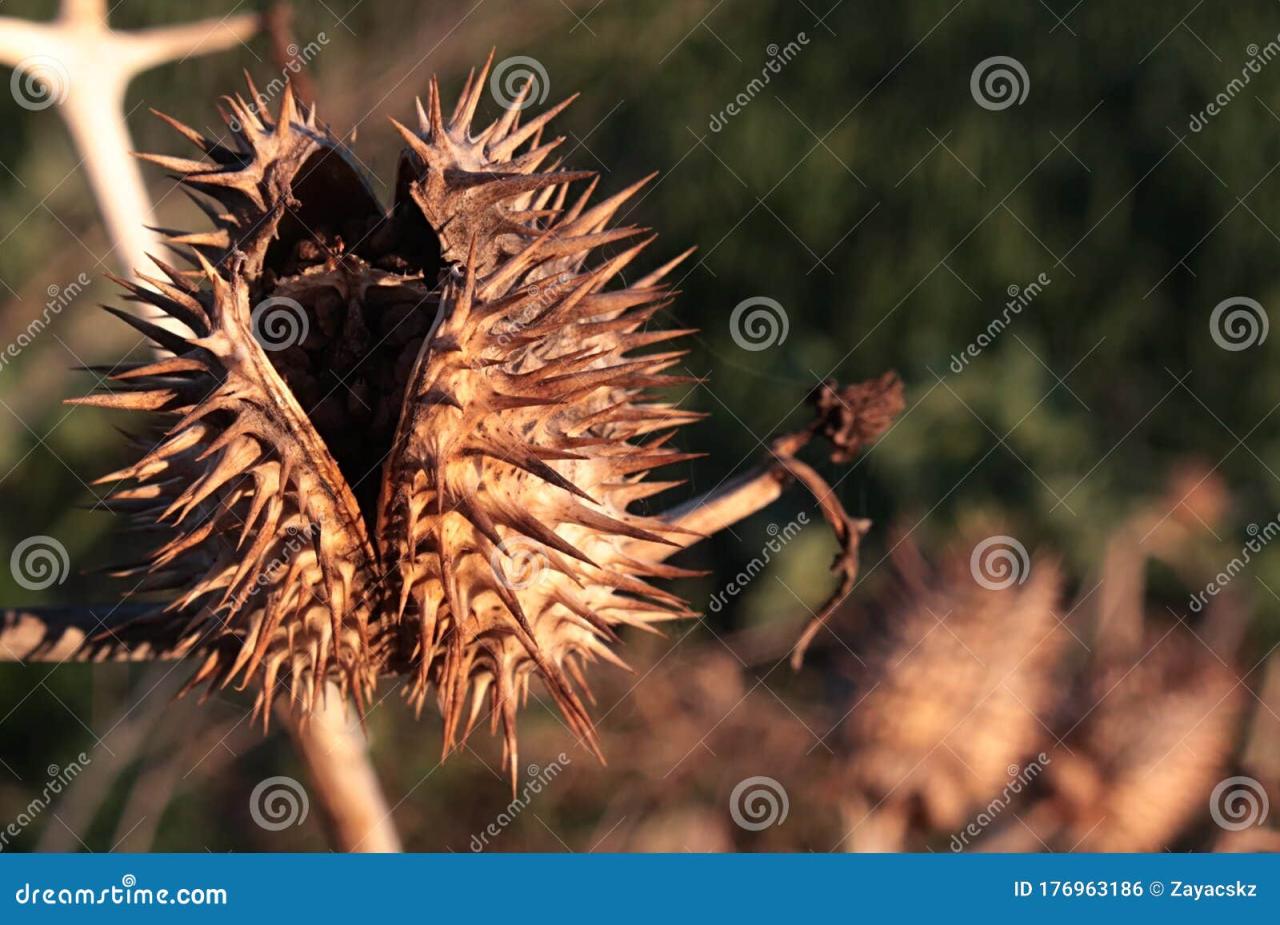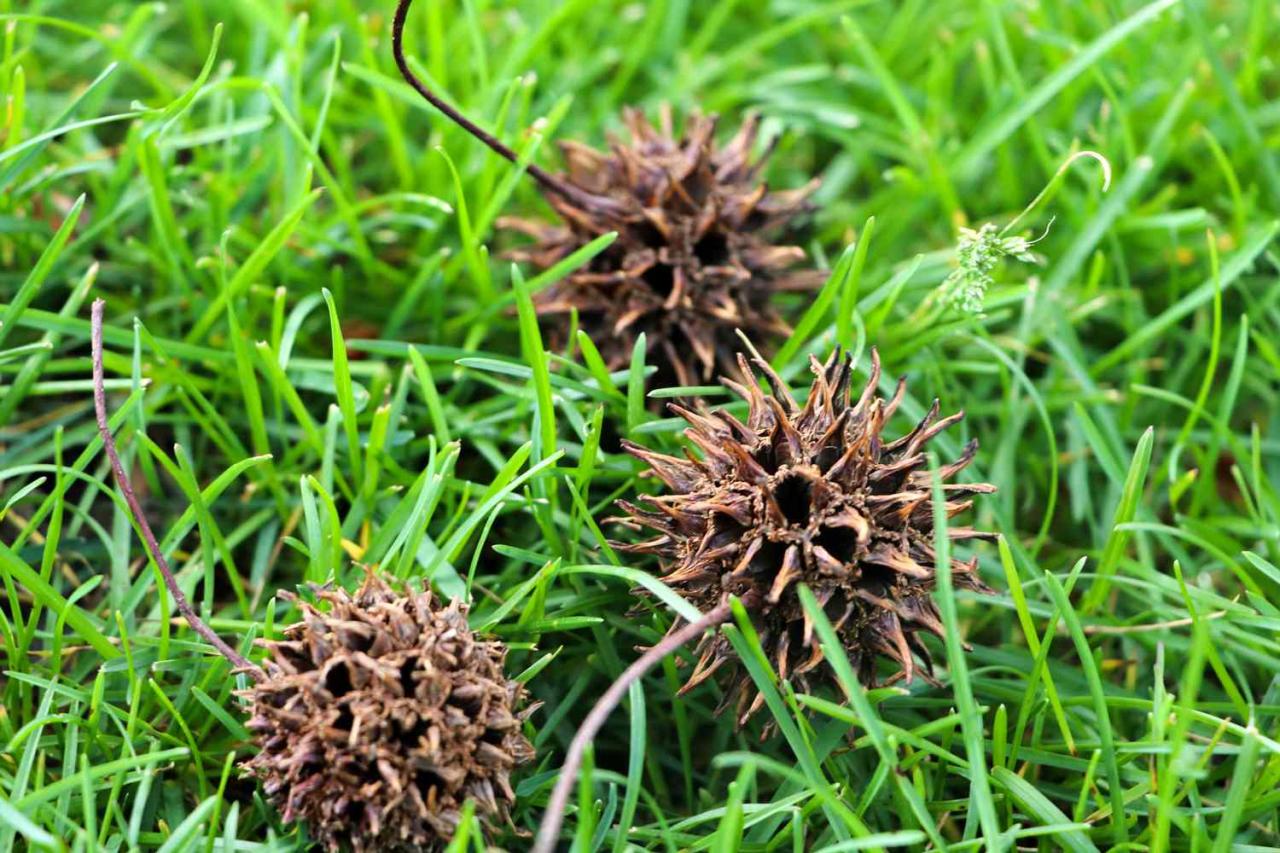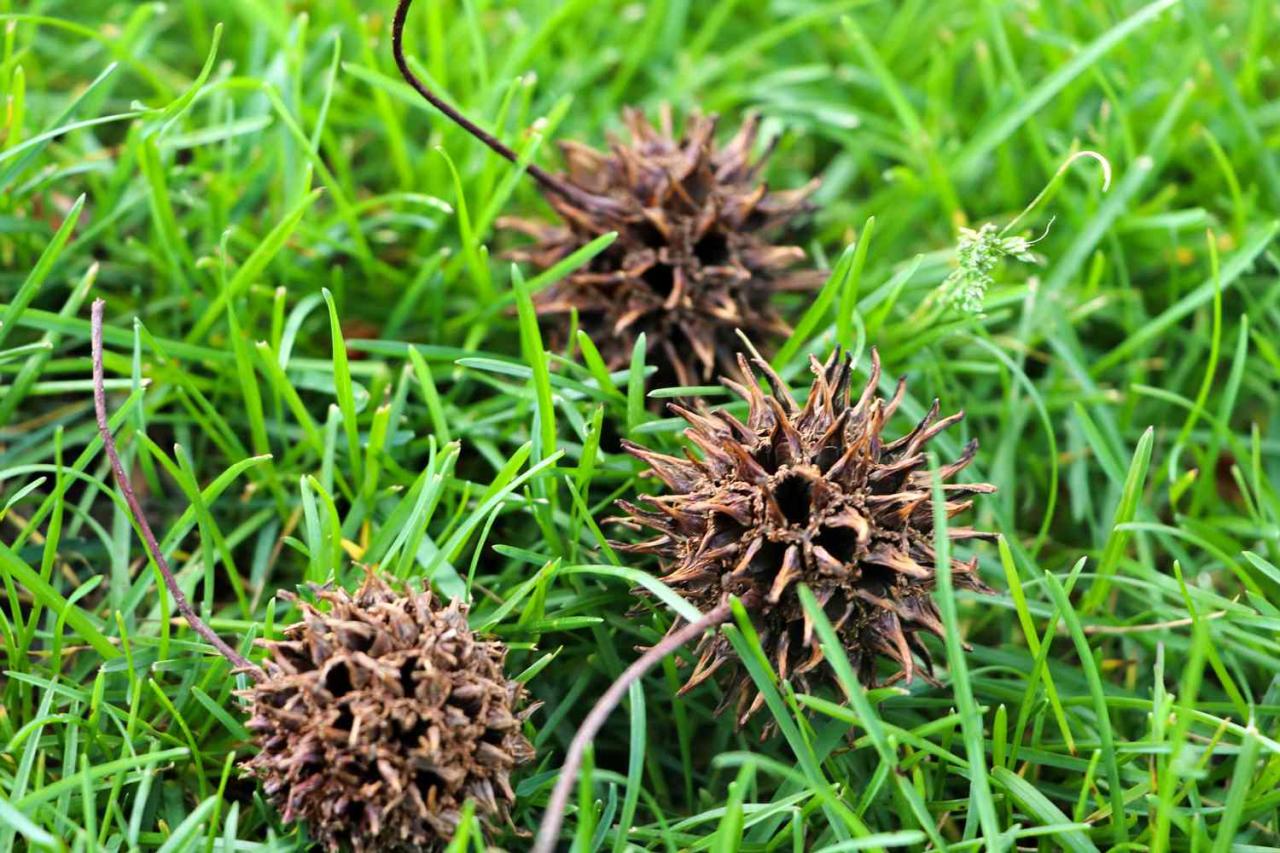Unlock the Mystery of Spiky Seeds: Everything You Need to Know – Have you ever wondered why some seeds are spiky? It’s more than just a quirky design; it’s a vital strategy for survival in the plant kingdom. These prickly appendages serve a crucial purpose: seed dispersal.
From the gentle sway of wind to the hurried steps of animals, spiky seeds have evolved ingenious ways to travel, ensuring the continuation of their species.
This journey delves into the fascinating world of spiky seeds, exploring their evolutionary origins, diverse dispersal methods, and surprising benefits. We’ll uncover the science behind their prickly nature, the challenges they present, and their surprising influence on human culture.
Introduction to Spiky Seeds

Spiky seeds, also known as burrs or hitchhikers, are a fascinating and often overlooked aspect of the plant kingdom. Their unique morphology, characterized by sharp projections, spines, or hooks, plays a crucial role in their dispersal and survival. The evolution of spiky seeds is a testament to the power of natural selection.
These adaptations have enabled plants to overcome the limitations of wind or water dispersal and ensure the successful propagation of their species. By clinging to the fur of animals, clothing, or other surfaces, spiky seeds can travel long distances, escaping the immediate vicinity of the parent plant and increasing their chances of finding suitable conditions for germination.
Types of Spiky Seeds
Spiky seeds come in a wide variety of shapes and sizes, each tailored to its specific dispersal mechanism. Some common examples include:
- Burrs:These seeds have numerous hooked spines that easily attach to fur or clothing. Examples include cocklebur ( Xanthium strumarium) and burdock ( Arctium lappa).
- Stickseeds:These seeds have long, sticky barbs that cling to fur or feathers. Examples include beggar’s ticks ( Bidensspp.) and sandbur ( Cenchrusspp.).
- Awned seeds:These seeds have sharp, bristle-like structures called awns that can penetrate soil or attach to clothing. Examples include wild oats ( Avena fatua) and foxtail barley ( Hordeum jubatum).
The Science Behind Spiky Seeds
Spiky seeds are fascinating adaptations that plants have developed to ensure their survival and spread. These seeds have evolved unique mechanisms to disperse themselves effectively, taking advantage of various environmental factors and interactions with other organisms. This section will delve into the science behind spiky seeds, exploring the forces that drive their dispersal and the strategies they employ to reach new locations.
Seed Dispersal Mechanisms
The spiky nature of these seeds plays a crucial role in their dispersal. The spikes act as hooks or barbs, enabling the seeds to attach themselves to passing animals, clothing, or other objects. This clinging ability allows the seeds to travel long distances, far beyond the reach of the parent plant.
Role of Wind, Water, and Animals
Wind Dispersal
While wind dispersal is not the primary mechanism for spiky seeds, it can still play a role. Some spiky seeds may have small, lightweight structures that allow them to be carried by the wind, particularly in open areas or when the seeds are attached to light objects.
Water Dispersal
Water dispersal is also less common for spiky seeds. The spikes can hinder their ability to float on water, making them less likely to be carried by currents. However, some spiky seeds may have adaptations that allow them to survive brief periods in water, such as a waterproof coating or a buoyant structure.
Animal Dispersal
Animal dispersal is the most prevalent method for spiky seeds. The spikes allow the seeds to attach themselves to the fur, feathers, or clothing of animals. As the animals move, the seeds are transported to new locations, where they can germinate and establish new populations.
Methods of Seed Dispersal for Spiky Seeds
Spiky seeds have evolved various strategies for attaching themselves to animals. Some common methods include:
- Hooks and Barbs:Many spiky seeds have hooks or barbs that readily catch on to animal fur, feathers, or clothing. These structures are often sharp and curved, making them difficult to detach. For example, the seeds of the burdock plant have numerous hooks that easily attach to clothing and animal fur.
- Sticky Substances:Some spiky seeds produce sticky substances that help them adhere to surfaces. These substances can be found on the seed coat or on specialized structures, such as glands or hairs. The sticky substance can trap the seed to an animal’s fur or clothing.
- Burrs:Burrs are a type of spiky seed that are particularly effective at attaching to animals. They have numerous hooks or barbs that are arranged in a way that makes them difficult to remove.
Comparison of Seed Dispersal Methods
Method |
Advantages |
Disadvantages |
Examples |
|---|---|---|---|
Wind dispersal |
Can travel long distances |
Not effective in all environments |
Dandelion seeds |
Water dispersal |
Can reach new areas |
Limited by water availability |
Coconut seeds |
Animal dispersal |
Efficient and widespread |
Dependent on animal activity |
Burdock seeds, cocklebur seeds |
The Benefits of Spiky Seeds: Unlock The Mystery Of Spiky Seeds: Everything You Need To Know
Spiky seeds, with their unique and often formidable appearance, serve a vital role in the plant kingdom. Their prickly exterior is not just a decorative feature but a strategic adaptation that enhances plant reproduction and survival, contributing significantly to plant diversity and ecosystem balance.
The Advantages of Spiky Seeds for Plant Reproduction and Survival
Spiky seeds possess several advantages that enhance their chances of successful reproduction and survival. Their spiky nature acts as a defense mechanism, protecting them from herbivores and other predators. This prickly barrier deters animals from consuming the seeds, ensuring their survival and the potential for germination.
- Dispersal by Animals:The spiky nature of these seeds can facilitate dispersal by animals. As animals brush against the plants, the seeds attach themselves to their fur or feathers, effectively hitchhiking to new locations. This method of dispersal, known as epizoochory, helps plants colonize new areas and avoid competition with their parent plants.
- Wind Dispersal:Some spiky seeds have evolved to be dispersed by wind. The spiky structure can act as a sail, catching the wind and carrying the seeds to new locations. This mechanism, known as anemochory, allows plants to spread their offspring over vast distances, increasing their chances of finding suitable conditions for germination.
- Protection from Germination Inhibition:The spiky seed coat can also act as a protective barrier, preventing the seed from germinating prematurely. This is particularly important in environments where conditions are not suitable for germination, such as during dry seasons or periods of extreme temperatures.
Spiky Seeds and Plant Diversity
Spiky seeds play a significant role in maintaining plant diversity. Their dispersal mechanisms, facilitated by their spiky structure, contribute to the distribution of plants across different habitats. This dispersal ensures that new populations of plants can establish themselves in diverse locations, leading to increased genetic diversity and the evolution of new plant species.
Examples of Plants with Spiky Seeds
Several plant species have evolved spiky seeds to adapt to specific environments and enhance their survival.
- Burdock (Arctium lappa): This plant’s spiky seeds are famous for their ability to attach themselves to animal fur, facilitating dispersal. The hooks on the seeds inspired the invention of Velcro.
- Cocklebur (Xanthium strumarium): The spiky seeds of cocklebur are dispersed by animals, sticking to their fur. These seeds can survive for long periods, allowing the plant to colonize new areas.
- Sandbur (Cenchrus longispinus): This plant has spiky seeds that can penetrate animal skin and even footwear, ensuring their dispersal and survival.
The Challenges of Spiky Seeds
While spiky seeds serve a crucial purpose in plant dispersal, their sharp, prickly nature can pose challenges for both animals and humans. The presence of these seeds can be a nuisance, leading to discomfort, injury, and even economic losses.
The Impact on Animals
Spiky seeds can be a source of discomfort and injury for animals, particularly those that consume them or come into contact with them. The sharp points can cause irritation, puncture wounds, or even internal damage. Some animals may experience difficulty swallowing or digesting these seeds, leading to choking or digestive problems.
For instance, livestock grazing in fields with spiky seeds like burdock may experience skin irritation and infections. Birds, too, can be affected, as the seeds can become lodged in their feathers or beaks, causing discomfort and hindering their ability to fly.
The Impact on Humans, Unlock the Mystery of Spiky Seeds: Everything You Need to Know
Spiky seeds can be a nuisance for humans, especially in agricultural settings and recreational areas. Their sharp points can puncture skin, leading to discomfort, infection, and even allergic reactions.
Impacts on Agriculture
Spiky seeds can cause significant problems in agriculture, impacting crop yields and hindering harvesting efforts.
- Reduced Crop Yields:The presence of spiky seeds can affect the growth and yield of crops by competing for resources like sunlight, water, and nutrients.
- Harvesting Difficulties:Spiky seeds can become entangled in farm equipment, causing damage and delaying harvesting processes.
- Contamination of Produce:Spiky seeds can contaminate harvested produce, reducing its market value and making it difficult to sell.
Impacts on Human Health
Spiky seeds can cause injury and discomfort to humans.
- Skin Punctures:The sharp points of spiky seeds can easily puncture human skin, causing pain, irritation, and infection.
- Allergic Reactions:Some individuals may experience allergic reactions to spiky seeds, resulting in rashes, itching, and even difficulty breathing.
- Eye Injuries:Spiky seeds can cause severe eye injuries, particularly if they become lodged in the eye.
Examples of Spiky Seeds and Their Impacts
Spiky seeds are found in a variety of plants, each posing unique challenges.
- Burdock (Arctium lappa):The burdock plant produces spiky seeds that readily attach to animal fur and clothing, leading to discomfort and the spread of the plant.
- Sandbur (Cenchrus longispinus):Sandbur seeds are known for their sharp, barbed spines that can easily penetrate skin and cause pain and infection.
- Cocklebur (Xanthium strumarium):Cocklebur seeds are covered in sharp spines that can irritate the skin and cause allergic reactions.
Spiky Seeds in Human Culture

Spiky seeds, with their intriguing forms and diverse properties, have captivated human imagination for centuries, leaving their mark on various aspects of culture, from art and literature to traditional medicine and design. Their unique characteristics have inspired creativity and innovation, making them more than just botanical curiosities.
Spiky Seeds in Art, Literature, and Folklore
Spiky seeds have found their way into various forms of artistic expression, reflecting their captivating appearance and symbolic significance. In art, they have been depicted in paintings, sculptures, and even jewelry, often representing themes of protection, resilience, and the beauty of nature’s intricate details.
In literature, spiky seeds have served as metaphors for various concepts, such as the challenges of life, the power of nature, and the beauty of imperfection. For example, the spiky seedpod of the
Unlocking the secrets of spiky seeds can be a rewarding journey, leading to vibrant new plant life. While some seeds require specific germination techniques, others, like African violets, thrive through vegetative propagation. For those looking to explore the world of African violet propagation, Cut, Root, Grow: Master African Violet Propagation offers a comprehensive guide.
From leaf cuttings to division, this guide provides the tools and knowledge needed to cultivate new African violet plants, complementing your understanding of seed propagation.
Acacia nilotica*, commonly known as the “babul tree,” is often used as a symbol of strength and resilience in Indian folklore, representing the ability to overcome adversity.
Spiky Seeds in Traditional Medicine and Crafts
Spiky seeds have long been valued for their medicinal properties and have played a vital role in traditional medicine systems worldwide. The spiky seed of the
- Trigonella foenum-graecum*, known as fenugreek, has been used to treat digestive problems, diabetes, and other ailments. In some cultures, the spiky seeds of the
- Cannabis sativa* plant, known as hemp seeds, are believed to have calming and therapeutic effects. Beyond their medicinal applications, spiky seeds have also been used in traditional crafts. For example, the spiky seeds of the
- Trapa natans*, commonly known as water chestnut, are used to make jewelry and decorative items in Southeast Asia.
Spiky Seeds Inspiring Design and Innovation
The unique shapes and textures of spiky seeds have inspired designers and innovators to create novel products and solutions. For example, the spiky seed of the
- Galium aparine*, known as “cleavers,” has inspired the development of Velcro, a popular fastening system. The intricate structure of the seed’s hooks, which allow it to cling to clothing and animal fur, provided the blueprint for this ingenious invention.
In architecture, the spiky seed of the
- Echinocactus grusonii*, commonly known as the “golden barrel cactus,” has inspired the design of buildings with sustainable cooling systems. The cactus’s spiky exterior provides natural insulation, reducing the need for artificial cooling and promoting energy efficiency.
The Future of Spiky Seeds

The future of spiky seeds is intertwined with the evolving challenges of our planet, particularly climate change and the need for sustainable solutions. As we navigate these complex issues, spiky seeds offer a unique perspective and potential solutions for a more resilient future.
Climate Change and Spiky Seed Dispersal
Climate change poses significant threats to plant diversity and ecosystem stability. Spiky seeds, with their diverse dispersal mechanisms, are uniquely positioned to play a crucial role in mitigating these threats. As temperatures rise and weather patterns become more unpredictable, the ability of spiky seeds to travel long distances and colonize new areas becomes increasingly important.
- Increased dispersal distances:Spiky seeds, often dispersed by animals, can travel further as animals seek new food sources and habitats in response to changing environmental conditions. This can help plants colonize areas that were previously inaccessible, promoting genetic diversity and resilience.
- Adaptation to extreme weather:Spiky seeds, with their protective coverings, can withstand harsh weather conditions, including droughts, floods, and wildfires. This resilience allows them to survive in environments that are becoming increasingly challenging for other plants. For example, the burdock ( Arctium lappa) with its spiky seeds, can survive and thrive in disturbed environments, even after a wildfire.
Unlocking the secrets of spiky seeds can reveal fascinating propagation methods. For example, understanding the unique structure of African violet leaves allows for a quick and easy propagation process, resulting in new plants in less than a week. Check out this guide on How to Propagate African Violets in Less Than a Week to learn more.
By understanding the anatomy of these spiky seeds, you can unlock a world of propagation possibilities, from simple leaf cuttings to more advanced techniques.
Spiky Seeds in Biodiversity Conservation and Sustainable Agriculture
Spiky seeds are valuable assets in biodiversity conservation and sustainable agriculture. Their unique characteristics can contribute to the preservation of ecosystems and the development of more resilient and efficient farming practices.
- Natural seed dispersal:Spiky seeds can promote natural seed dispersal, contributing to the reforestation of degraded areas and the restoration of ecosystems. This is particularly important in areas where natural dispersal mechanisms have been disrupted, such as fragmented landscapes or areas affected by human activities.
For example, the seeds of the prickly pear cactus ( Opuntia ficus-indica), dispersed by animals, have played a significant role in the restoration of degraded lands in arid and semi-arid regions.
- No-till agriculture:Spiky seeds can facilitate no-till agriculture, a sustainable farming practice that reduces soil erosion and improves soil health. Spiky seeds, dispersed by animals, can establish themselves in undisturbed soil, minimizing the need for tilling and promoting biodiversity. This is particularly relevant in areas with fragile soils or where conventional farming practices have led to soil degradation.
For example, the seeds of the wild oat ( Avena fatua) with their spiky awns, can penetrate the soil without tilling, promoting natural regeneration in agricultural fields.
Biomimicry and Technological Advancements
The unique characteristics of spiky seeds, such as their burrs and hooks, have inspired technological advancements in fields like biomimicry and engineering. Researchers and engineers are harnessing the principles of spiky seed design to create innovative solutions for a wide range of applications.
- Bio-inspired adhesives:The burrs of spiky seeds, such as the cocklebur ( Xanthium strumarium), have inspired the development of bio-inspired adhesives. These adhesives have the potential to be used in various applications, including medical devices, wound dressings, and industrial manufacturing.
- Micro-robotics:The hooks and barbs of spiky seeds can be used to design micro-robots that can navigate complex environments, such as the human body or contaminated areas. These micro-robots could be used for targeted drug delivery, environmental cleanup, and other applications.
Conclusion
The intricate world of spiky seeds offers a glimpse into the remarkable adaptations of nature. These seemingly simple structures hold secrets of survival, diversity, and even inspiration for human innovation. As we continue to learn about the mysteries of spiky seeds, we gain a deeper appreciation for the interconnectedness of life on Earth and the vital role these remarkable structures play in maintaining the balance of our ecosystems.
FAQ Explained
What are some examples of plants with spiky seeds?
Common examples include burdock, cocklebur, and thistles. These plants rely on their spiky seeds to attach to animal fur or clothing, facilitating long-distance dispersal.
Are all spiky seeds harmful to humans?
While some spiky seeds can cause irritation or injury, many are harmless. It’s important to identify the specific species before handling any unknown seeds.
How do spiky seeds contribute to plant diversity?
Spiky seeds often travel long distances, allowing plants to colonize new areas and diversify their genetic pool. This promotes adaptation and resilience within plant populations.
